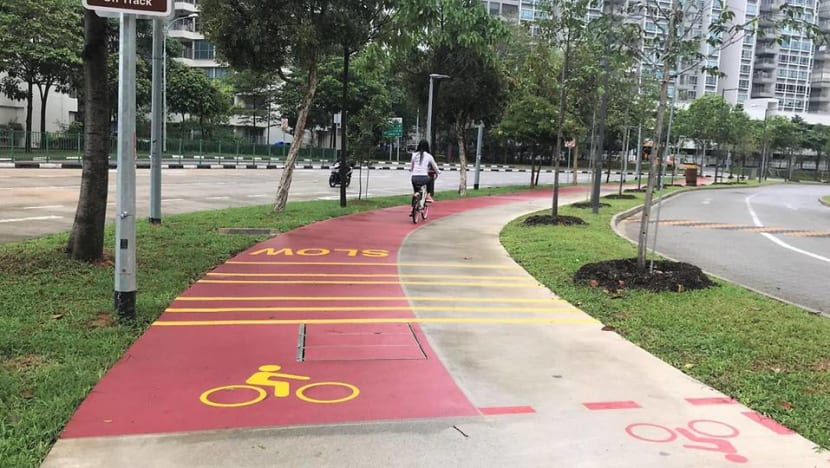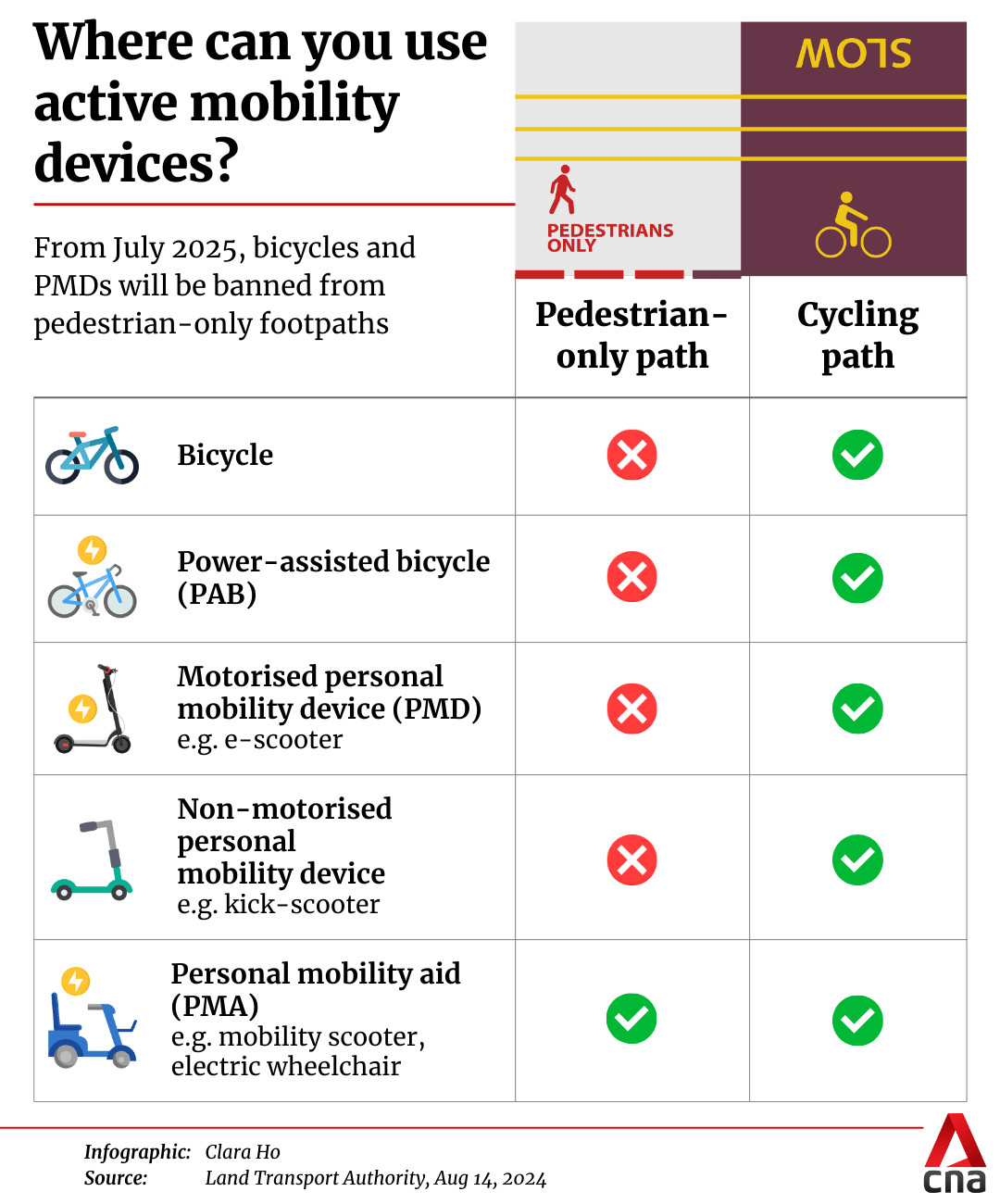FAQ: What you need to know about the ban on bicycles, kick-scooters on pedestrian-only paths
Why is LTA converting footpaths to pedestrian-only paths where bicycles and non-motorised personal mobility devices will be banned? What are the penalties?


This audio is generated by an AI tool.
SINGAPORE: Footpaths that are adjacent to cycling lanes will progressively be turned into pedestrian-only paths - and with this move, bicycles and non-motorised personal mobility devices (PMDs) will not be allowed on pedestrian-only paths.
Enforcement action will start in July 2025, said the Land Transport Authority (LTA), so there is time for both riders and pedestrians to be familiar with the rules.
Here's what you need to know:
WHERE CAN YOU RIDE BICYCLES AND OTHER MOBILITY DEVICES?
Bicycles and non-motorised PMDs like kick-scooters are currently allowed on footpaths with a speed limit of 10kmh, although riders and pedestrians are encouraged to stick to their own paths.
But this will change from the fourth quarter of 2024 when LTA converts these footpaths into pedestrian-only paths.
When that happens, the only rides allowed on pedestrian-only paths are for people on personal mobility aid devices like mobility scooters and electric wheelchairs. And by the end of next year, they must keep to a speed limit of not more than 6kmh, which is similar to brisk-walking speeds.
Bicycles, e-scooters, kick-scooters and skateboards will have to stick to cycling paths.

WHAT ABOUT CHILDREN RIDING A TRICYCLE?
Children travelling on a "wheeled toy" are considered pedestrians and are, therefore, allowed on pedestrian-only paths, said LTA.
A "wheeled toy" refers to a child’s pedal car, scooter, tricycle or a similar toy, but only when it is being used by a child who is below 12 years old.
WHY THE MOVE TO CONVERT FOOTPATHS?
It's meant to improve safety for all, especially pedestrians young and old.
Authorities are implementing this now because Singapore has since developed more than 200km of cycling lanes that run parallel to footpaths.
"Previously, we didn't have enough of the facilities to separate out the (pedestrians and riders)," Transport Minister Chee Hong Tat told reporters on Wednesday (Aug 14).
"Now that we have 200km out of the 600km of dedicated cycling lanes, we feel that this is the right time for us to make this move," he added.
"The purpose is to enhance safety for our residents, especially for our seniors and young children when they walk."
Mr Chee said the reason for the move was not due to a rise in active mobility accidents.
In fact, the number of active mobility accidents on footpaths has been falling since 2019.
“In 2019, we had about 303 cases. Last year in 2023, this came down to 70-plus cases. So this is not because the paths have become more dangerous,” he said.
WHAT ARE THE PENALTIES FOR BREACHING THE RULE?
Those caught riding on pedestrian-only paths in breach of the rule can be fined up to S$2,000 (US$1,520) or jailed for up to three months, or both.
To allow people to adjust to the new rules, there will be a grace period before enforcement action starts from Jul 1, 2025.
In the meantime, LTA said its ground team will "engage and educate" cyclists and non-motorised PMD users if they are riding on the wrong path.
"Advisories will also be provided to path users to educate them," the agency added.
ARE THERE MITIGATING FACTORS?
Mr Chee said LTA will have to be "flexible and reasonable" in the enforcement approach.
If cyclists have to avoid obstacles and veer briefly into the pedestrian-only path and do so safely, that is "not unacceptable", Mr Chee explained.
"Likewise, I think it's also not unacceptable for pedestrians to go onto the bicycle lanes to avoid obstacles, but we encourage them to stick to their own lanes."
In response to CNA's queries, LTA stressed that it will take action against those who are speeding or riding in a rash and reckless manner, regardless of the path used.

WILL THERE BE PENALTIES FOR PEDESTRIANS ON CYCLING PATHS?
No enforcement action will be taken against pedestrians who veer into cycling paths.
If active mobility enforcement officers encounter pedestrians on cycling paths, their approach is to advise them to use the footpaths.
WHAT ABOUT RULES FOR SHARED PATHS?
Shared paths can be used by both pedestrians and users of active mobility devices who must keep to a speed limit of 25kmh.
According to a code of conduct for the use of public paths, some good practices for pedestrians include keeping left as far as possible except when overtaking another pedestrian.
A rider of a bicycle or non-motorised PMD should similarly keep to the left except when overtaking a pedestrian or another rider.
The code of conduct also states that they should always give way to any pedestrian on the same shared path or at an intersection with the footpath or shared path.
















